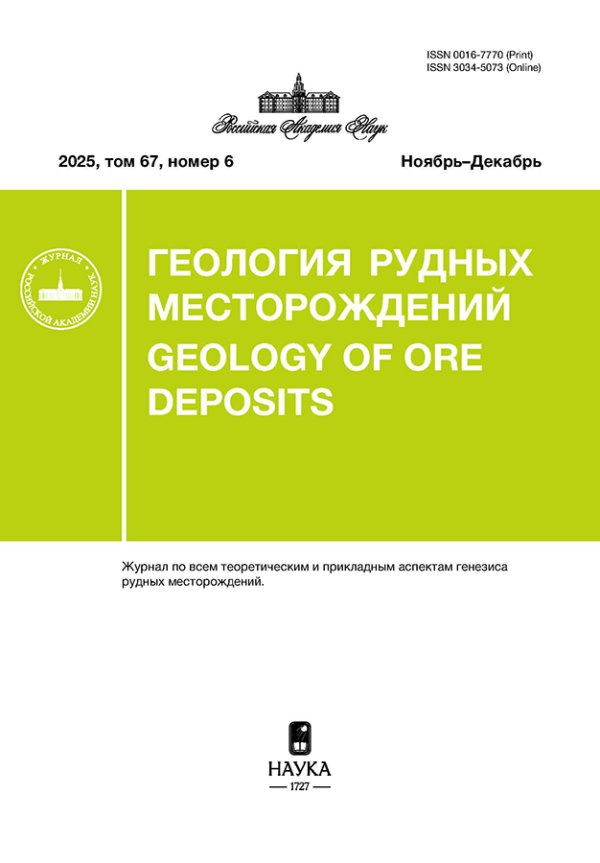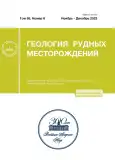Sulfide Mineralization of Carbonate–Silicate Veins in Early Proterozoic Metabasites of North Karelia: Mineral Assemblages, Mineral Forms of Silver, and Fluid Inclusions
- Authors: Volkov I.S.1, Prokofiev V.Y.1, Kozlovskii V.M.1, Pertsev A.N.1
-
Affiliations:
- Institute of Geology of Ore Deposits, Petrography, Mineralogy and Geochemistry, Russian Academy of Sciences
- Issue: Vol 65, No 6 (2023)
- Pages: 551-578
- Section: Articles
- URL: https://journals.rcsi.science/0016-7770/article/view/231645
- DOI: https://doi.org/10.31857/S0016777023060102
- EDN: https://elibrary.ru/IAPEIE
- ID: 231645
Cite item
Full Text
Abstract
The work presents the first data on sulfide mineralization in carbonate–silicate veins, which are widespread on the islands and coast of the White Sea (North Karelia), associating with Early Proterozoic metamorphosed gabbroid bodies. The veins with Fe–Cu sulfide mineralization up to ore occurrences are localized within metabasite bodies and along their contacts with host gneisses. During the study of the mineral composition of the veins, the main assemblages of sulfide minerals were identified: chalcopyrite –bornite ± chlorite ± selenides and Pb–Ag tellurides (B1); digenite–bornite ± selenides and Pb, Ag, and Pd tellurides (B2); pyrite–bornite ± chalcopyrite (B3); marcasite–pyrite–bornite–chalcopyrite (B4); and siegenite–chalcopyrite ± acanthite ± chlorargyrite. The development of sulfide associations, as well as quartz–chlorite aggregates, was related to the late stage of vein formation. Inductively coupled plasma and laser ablation mass spectrometry analyses showed that bornite from association B1 has the highest silver content (up to 675 ppm) and, in terms of Ag, Se, and Bi contents, is closest to bornite from low-temperature epithermal, skarn, and high-temperature vein deposits. In general, bornite is the main Ag carrier in the studied associations, while digenite containing up to 1000 ppm Ag, as well as discrete silver minerals (selenides, tellurides, acanthite, and chlorargyrite), occur in subordinate quantities. Fluid inclusions in quartz from sulfide associations, as well as from a sulfide-free carbonate–silicate vein, were studied by cryo- and thermometric methods. It is established that mineralization at the late stages of vein formation was related to heterogeneous CO2–H2O–NaCl metamorphic fluid. Carbon dioxide fluid inclusions were captured by vein quartz at temperature of 253–314°C and pressure of 2 ± 1 kbar. Water–salt inclusions were captured in a wider temperature range of 100–500°С. The highest temperature fluid inclusions with temperatures of homogenization >300°С are characteristic of quartz veinlets of the siegenite–chalcopyrite association with Ag sulfide and chlorargyrite.
About the authors
I. S. Volkov
Institute of Geology of Ore Deposits, Petrography, Mineralogy and Geochemistry, Russian Academy of Sciences
Email: IvanVolkov19@yandex.ru
119017, Moscow, Russia
V. Yu. Prokofiev
Institute of Geology of Ore Deposits, Petrography, Mineralogy and Geochemistry, Russian Academy of Sciences
Email: IvanVolkov19@yandex.ru
119017, Moscow, Russia
V. M. Kozlovskii
Institute of Geology of Ore Deposits, Petrography, Mineralogy and Geochemistry, Russian Academy of Sciences
Email: IvanVolkov19@yandex.ru
119017, Moscow, Russia
A. N. Pertsev
Institute of Geology of Ore Deposits, Petrography, Mineralogy and Geochemistry, Russian Academy of Sciences
Author for correspondence.
Email: IvanVolkov19@yandex.ru
119017, Moscow, Russia
References
- Балаганский В.В. Главные этапы тектонического развития северо-востока Балтийского щита в палеопротерозое. Автореф. дис. … д-ра геол.-мин. наук. СПб.: ИГГД РАН, 2002. 32 с.
- Балаганский В.В., Глазнев В.Н., Осипенко Л.Г. Раннепротерозойская эволюция северо-востока Балтийского щита: террейновый анализ // Геотектоника. 1998. № 2. С. 16–28.
- Березин А.В., Скублов С.Г. Эклогитоподобные апогаббровые породы Керетского архипелага (о-ва Сидоров и Большая Илейка, Белое море): особенности состава, условия и возраст метаморфизма // Петрология. 2014. Т. 22. № 3. С. 265–286. https://doi.org/10.7868/S0869590314030030
- Борисенко А.С. Изучение солевого состава газовожидких включений в минералах методом криометрии // Геология и геофизика. 1977. № 8. С. 16–27.
- Волков И.С., Козловский В.М. Стадийность и условия формирования карбонатно-силикатных жил и околожильных ореолов в раннепротерозойских комплексах Беломорского подвижного пояса, Северная Карелия // Петрология. 2023. Т. 31. № 5.
- Глебовицкий В.А. Ранний докембрий Балтийского щита. СПб.: Наука, 2005. 711 с
- Козловский В.М., Аранович Л.Я. Петрология и термобарометрия эклогитовых пород Красногубского дайкового поля, Беломорский подвижный пояс // Петрология. 2010. Т. 18. № 1 С. 29–52.
- Козловский В.М., Травин В.В., Саватенков В.М., Терентьева Л.Б., Сальникова, Е.Б., Курдюков Е.Б. Термобарометрия палеопротерозойских метаморфических событий центральной части Беломорского подвижного пояса, Северная Карелия // Петрология. 2020. Т. 28. № 2. С. 184–209. https://doi.org/10.31857/S0869590320010033
- Котельников А.Р., Сук Н.И., Котельникова З.А., Щекина Т.И., Калинин Г.М. Минеральные геотермометры для низкотемпературных парагенезисов // Вестник ОНЗ РАН. 2012. Т. 4. № 9001. https://doi.org/10.2205/2012NZ_ASEMPG
- Лебедев В.И. К минералогии кварцево-карбонатных жил северной Карелии // Известия Карело-финского филиала Академии Наук СССР. 1950. № 1. С. 3–36.
- Никитин Ю.В. Молибденитовое оруденение в жилах Северной Карелии. // Труды лаборатории геологии докембрия. Выпуск 9. М.–Л.: Изд.-во. АН СССР, 1960. С. 150–157.
- Прокофьев В.Ю., Наумов В.Б. Геохимические особенности рудообразующих растворов Зыряновского колчеданно-полиметаллического месторождения (Рудный Алтай) // Геохимия. 1987. № 3. С. 375–386.
- Реддер Э. Флюидные включения в минералах. М.: Мир, 1987. Т. 1. 560 с.
- Слабунов А.И. Геология и геодинамика архейских подвижный поясов на примере Беломорской провинции Фенноскандинавского щита // Институт геологии КарНЦ РАН. Петрозаводск: Карельский научный центр РАН. 2008. 296 с.
- Слабунов А.И., Балаганский В.В., Щипанский А.А. Мезоархей-палеопротерозойская эволюция земной коры Беломорскогй провинции Фенноскандинавского щита и тектоническая позиция эклогитов // Геология и геофизика. 2021. Т. 62. № 5. С. 650–677. https://doi.org/10.15372/GiG2021116
- Смирнова В.С., Солодкая Р.И. Геологическая карта СССР масштаба 1 : 200000. Серия Карельская лист Q-36XVI. Об. Записка. М.: Госгеолтеиздат // Государственное научно-техническое издательство литературы по геологии и охране недр. Москва. 1960. 60 с.
- Степанов В.С. Основной магматизм докембрия западного Беломорья // Ленинград: Наука, 1981 г. 216 с.
- Степанова А.В., Степанов В.С., Ларионов А.Н., Азимов П.Я., Егорова С.В., Ларионова Ю.О. Габбро-анортозиты 2.5 млрд лет в Беломорской провинции Фенноскандинавского щита: петрология и тектоническая позиция // Петрология. 2017. Т. 25(6). С. 581–608. https://doi.org/10.7868/S0869590317060061
- Шуркин К.А., Дук В.Л., Митрофанов Ф.П. Материалы к геологии и петрографии габбро-лабрадоритов архея Северной Карелии // Геология и абсолютный возраст докембрия Балтийского щита и Восточной Сибири. М. 1960. С. 120–149.
- Abedini A., Calagari A.A., Naseri H. Mineralization and REE geochemistry of hydrothermal quartz and calcite of the Helmesi vein-type copper deposit, NW Iran // Neues Jahrbuch für Geologie und Paläontologie-Abhandlungen. 2016. C. 123–134. https://doi.org/10.1127/njgpa/2016/0591
- Alm E., Broman C., Billström K., Sundbland K., Torssander P. Fluid characteristics and genesis of early Neoproterozoic orogenic gold-quartz veins in the Harnas area, southwestern Sweden // Econ. Geol. 2003. V. 98. № 7. P. 1311–1328. https://doi.org/10.2113/gsecongeo.98.7.1311
- Alm E., Sundblad K. Sveconorwegian polymetallic quartz veins in Sweden // Neues Jahrbuch für Mineralogie Monatshefte. 1994. V. 1994. № 1. P. 1–22.
- Bourdelle F., Parra T., Chopin C., Beyssac O. A new chlorite geothermometer for diagenetic to low-grade metamorphic conditions // Contrib. Mineral. Petrol. 2013. V. 165. № 4. https://doi.org/10.1007/s00410-012-0832-7
- Brown P. FLINCOR: a computer program for the reduction and investigation of fluid inclusion data // Amer. Mineralogist. 1989. V. 74. P. 1390–1393.
- Cathelineau M., Nieva D. A chlorite solid solution geothermometer the Los Azufres (Mexico) geothermal system // Contrib. Mineral. Petrol. 1985. V. 91. № 3. P. 235–244.
- Ciobanu C.L., Cook N.J., Ehrig K. Ore minerals down to the nanoscale: Cu-(Fe)-sulphides from the iron oxide copper gold deposit at Olympic Dam, South Australia //Ore Geol. Rev. 2017. V. 81. P. 1218–1235. https://doi.org/10.1016/j.oregeorev.2016.08.015
- Cook N.J., Ciobanu C.L., Danyushevsky L.V., Gilbert S. Minor and trace elements in bornite and associated Cu–(Fe)-sulfides: A LA-ICP-MS study bornite mineral chemistry //Geochim. Cosmochim. Acta. 2011. V. 75. № 21. P. 6473–6496. https://doi.org/10.1016/j.gca.2011.08.021
- Loidolt L.H. Quartz-feldspar-carbonate bodies of the Carrizo Mountains, Texas. The University of Arizona, 1970. 126 p.
- Paton C., Hellstorm J., Paul B., Woodhead J., Hergt J. Iolite: Freeware for the visualisation and processing of mass spectrometric data // J. Analytical Atomic Spectrometry. 2011. V. 26. № 12. P. 2508–2518.
- Raj R.M., Kumar S.N. Characterisation of selected sulphides associated with the granitic pegmatites of Nagamalai Pudukottai area, Madurai District, Tamil Nadu, India // J. Applied Geochem. 2015. V. 17. № 4. P. 444–450.
- Raj R.M., Kumar S.N. Geothermobarometry of granitic pegmatites of Nagamalai-Pudukottai area, Madurai Block, South India // Earth Sci. India. 2018. V. 11. P. 168–182.
- Sankar D.B., Prasad K.S.S. Petrology of Garimanipenta (copper mineralisation area), Nellore District, Andhra Pradesh, south India – A case study // Int. J. Sci. Environment and Technology. 2012. V. 1. № 4. P. 247–259.
- Sillitoe, R.H. Copper provinces // Society of Economic Geologists Special Publication 16, 2012. P. 1–18. https://doi.org/10.5382/SP.16.01
- So C.S., Chi S.J., Shelton K.L., Skinner B.J. Copper-bearing hydrothermal vein deposits in the Gyeongsang basin, Republic of Korea // Econ. Geol. 1985. V. 80. №. 1. P. 43–56. https://doi.org/10.2113/gsecongeo.80.1.43
- Stepanova A.V., Stepanov V.S., Larionov A.N., Salnikova E.B., Samsonov A.V., Azimov P., Egorova S.V., Babarina I.I, Larionova Y.O., Sukhanova M.A., Kervinen A.V., Maksimov O.A. Relicts of paleoproterozoic LIPs in the Belomorian Province, eastern Fennoscandian Shield: barcode reconstruction for a deeply eroded collisional orogen // Geol. Soc. London. Spec. Publ. 2022. V. 518. № 1. P. 101–128. https://doi.org/10.1144/SP518-2021-30
- Warr L.N. IMA–CNMNC approved mineral symbols // Mineral. Mag. 2021. V. 85. № 3. P. 291–320. https://doi.org/10.1180/mgm.2021.43
- Yund R.A., Kullerud G. Thermal stability of assemblages in the Cu–Fe–S system // J. Petrology. 1966. V. 7. № 3. P. 454–488. https://doi.org/10.1093/petrology/7.3.454
Supplementary files
























